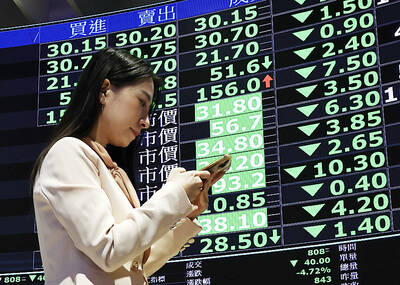Myanmar’s displaced Rohingya are using trade and technology to make the most of life in the world’s biggest refugee camp, with aid agencies hoping that odd jobs and blockchain deliver dignity along with extra money.
Seven years after hundreds of thousands of Rohingyas fled persecution at home for the crowded Cox’s Bazar camp in neighboring Bangladesh, a sharp fall in humanitarian aid has forced new survival habits.
Work is one way to top up the depleted food rations, with openings at international aid agencies and unofficial farm labor stints coveted to make life a little better.

Photo: Reuters
Rohingya are also using blockchain technology with their ration cards to keep track of what finances they do have — giving a greater sense of ownership even while living hand to mouth.
“Unfortunately this conflict is not nearing an end, and these people are going to need our help,” the US official in charge of supporting UN aid said.
“People [in the camp] should have more of an opportunity to improve their own lives and get involved in meaningful work,” US Representative to the UN Agencies for Food and Agriculture Jeffrey Prescott said on a recent visit to the sprawling site.
In 2017, about 730,000 Rohingya, a mostly Muslim minority denied citizenship in their Buddhist-majority nation, crossed the Bangladeshi border to Cox’s Bazar to escape a military crackdown at home.
Their arrival boosted an already crowded camp to nearly 1 million people, with families, friends and strangers jammed side by side in tens of thousands of huts made from bamboo and thin plastic sheets.
Once again, Myanmar’s Rohingya community is under threat of attacks and displacement at home as fighting between a powerful ethnic army and the country’s ruling junta escalates in the western state of Rakhine, aid agencies say.
Thousands are estimated to have fled toward Bangladesh since the middle of last month, and many of those still in Rakhine are in dire need of aid.
Conditions at the camp are hard and rations are now low, too, as competing conflicts — from Ukraine to the Middle East — swallow a growing share of the global aid pot.
Last year, the monthly ration in the camp was slashed from US$12 to US$8 per head as the world delivered only half of the £876 million (US$1.11 billion) that the UN had earmarked for Rohingya projects.
That ration is set to creep back up to US$11 after Prescott used last month’s visit to Cox’s Bazar to pledge an extra US$30.5 million in aid.
The UN World Food Programme (WFP) aims to reinstate a full US$12.50 monthly stipend by August, after the US aid pledge.
“The US$8 food ration was simply not enough to fill our stomachs over the entire month,” said Mohammed Salim, who lives in the camp with two wives and several children.
Until there is enough food to go around, aid agencies are innovating to try and help the refugees bridge some of the gap.
They are helping them find work and teaching Rohingya refugees to use digital technology while they wait on real life to resume.
Inside a large workshop made of bamboo and reeds, men and women sat in segregated sections working the production line for bags, baskets and clothes to sell in the local market.
Fatema Begum, who was just 15 when she moved to Bangladesh, makes handicrafts for 50 taka (US$0.43) an hour.
Workers are employed for four-month stints to win extra income and learn new skills, she said.
“Thanks to this job, I can get better snacks in the evening for myself and my kids,” the 22-year old said, as she cleaned and sliced aluminum packages to upcycle into bags.
Employed by international aid agencies, Rahima Khatun care for trees planted to restore a riverside forest destroyed during the Rohingya influx.
Given the small number of jobs available, along with the income they offer, candidates grab any opportunities offered — but proper, full time jobs are not allowed by the authorities.
Shops set up by refugees inside the camps have previously been bulldozed by the officials.
Many more Rohingya sneak out of the camps and work in the economy informally for US$3 to US$5 a day — 25 to 30 percent lower than Bangladeshi workers — stirring mixed feelings among locals.
“Our area has been tainted by Rohingya presence — as lots of trees have been chopped down to make room for the camps, while cheap Rohingya labor sometimes outcompetes local workers for farming jobs,” local farmer Abdur Rahman said.
Technology has also been used to help the refugees, bringing efficiency to the camp economy and some sense of ownership to people who lack life’s basics.
In 2017, the WFP introduced the world’s largest blockchain-based cash distribution system in the Rohingya camps — an innovation it has since expanded to provide aid from Lebanon to Ukraine.
Under the system, refugees can buy food with the monthly cash allocated to them through a digital wallet — so they do not need a bank account or to wait in line for rations.
Nur Khatun, 24, came to buy rice, oil and fruit for her family at an e-voucher outlet, paying with her digital card.
“I come to buy my weekly groceries as and when needed — and we don’t have to line up for getting our monthly rations at one go,” she said.
Aid workers say the tech gives refugees greater autonomy.
“Shopping with cards like other people gives them a sense of normalcy and dignity,” said Clara Ogando, head of digital solutions and innovation at the WFP.
However, technology has been a two-edged sword for the Rohingya.
In Myanmar, the government had used biometric data and an enforced identity system to monitor and target the Rohingya.
So UN agencies are careful to protect their information, sharing data only when necessary to deliver services.
WFP Representative to Bangladesh Dom Scalpelli said that the UN agencies try to ensure safe and fair use of the data — and their biometrics are not shared in the food distribution system.
Odd jobs and tech might help, but they would not deliver a better future, Bonn Center for Dependency and Slavery Studies researcher Anas Ansar said.
“None of these solve the question about the Rohingya people’s future — while the world’s attention keeps shifting to other contexts like Ukraine and Palestine,” he said.
“Ultimately there needs to be a long-term solution that ensures safety and dignity for the Rohingya people,” Ansar said.

SELL-OFF: Investors expect tariff-driven volatility as the local boarse reopens today, while analysts say government support and solid fundamentals would steady sentiment Local investors are bracing for a sharp market downturn today as the nation’s financial markets resume trading following a two-day closure for national holidays before the weekend, with sentiment rattled by US President Donald Trump’s sweeping tariff announcement. Trump’s unveiling of new “reciprocal tariffs” on Wednesday triggered a sell-off in global markets, with the FTSE Taiwan Index Futures — a benchmark for Taiwanese equities traded in Singapore — tumbling 9.2 percent over the past two sessions. Meanwhile, the American depositary receipts (ADRs) of Taiwan Semiconductor Manufacturing Co (TSMC, 台積電), the most heavily weighted stock on the TAIEX, plunged 13.8 percent in

A wave of stop-loss selling and panic selling hit Taiwan's stock market at its opening today, with the weighted index plunging 2,086 points — a drop of more than 9.7 percent — marking the largest intraday point and percentage loss on record. The index bottomed out at 19,212.02, while futures were locked limit-down, with more than 1,000 stocks hitting their daily drop limit. Three heavyweight stocks — Taiwan Semiconductor Manufacturing Co (TSMC, 台積電), Hon Hai Precision Industry Co (Foxconn, 鴻海精密) and MediaTek (聯發科) — hit their limit-down prices as soon as the market opened, falling to NT$848 (US$25.54), NT$138.5 and NT$1,295 respectively. TSMC's

TARIFFS: The global ‘panic atmosphere remains strong,’ and foreign investors have continued to sell their holdings since the start of the year, the Ministry of Finance said The government yesterday authorized the activation of its NT$500 billion (US$15.15 billion) National Stabilization Fund (NSF) to prop up the local stock market after two days of sharp falls in reaction to US President Donald Trump’s new import tariffs. The Ministry of Finance said in a statement after the market close that the steering committee of the fund had been given the go-ahead to intervene in the market to bolster Taiwanese shares in a time of crisis. The fund has been authorized to use its assets “to carry out market stabilization tasks as appropriate to maintain the stability of Taiwan’s

In a small town in Paraguay, a showdown is brewing between traditional producers of yerba mate, a bitter herbal tea popular across South America, and miners of a shinier treasure: gold. A rush for the precious metal is pitting mate growers and indigenous groups against the expanding operations of small-scale miners who, until recently, were their neighbors, not nemeses. “They [the miners] have destroyed everything... The canals, springs, swamps,” said Vidal Britez, president of the Yerba Mate Producers’ Association of the town of Paso Yobai, about 210km east of capital Asuncion. “You can see the pollution from the dead fish.